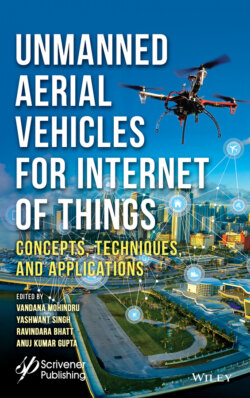Читать книгу Unmanned Aerial Vehicles for Internet of Things (IoT) - Группа авторов - Страница 55
2.2.3 Millimeter Wave Cellular Connected UAVs
ОглавлениеThe challenges encountered by cellular networks operating at mmWaves (Millimeter Waves) can be enumerated as, high attenuation, reduced transmission range, increased scattering, high penetration losses when encountering objects, frequent signal blockage, etc. These can be overcome to a certain extent by the use of UAV-assisted cellular networks. But such UAV based wireless communication systems operating at mmWaves also face certain issues. The channel characteristics of UAV mmWave communication networks are quite different as compared to those of the traditional UAV communication networks as well as the terrestrial cellular network communication. Channel models incorporating air to air channels, air to ground channel, air to sea channels need to be designed for UAV mmWave communication networks. There is need to carry out both empirical as well as analytical studies for UAV mmWave channels used in dense urban scenarios. Need arises to develop models that would assist in study of effects of weather on performance of UAV assisted mmWave networks, as mmWave propagation and the stability of UAV both get affected by rain and wind. The fast channel estimation methods should be developed to solve the problems due to reduced channel coherence time in high-mobility UAV communication systems. At mmWave frequencies more efficient beam training and tracking methods, which can handle rapid variations of path gain and fast deviations in angle of arrival and departure of beam, are required. Strategies to detect the abrupt changes and designing of smart precoders are required to improve the performance of UAV assisted mmWave communication systems. In UAV to BS mmWave communication, UAV detection and positioning is another critical challenge to be sorted out. In order to solve the interference problems, beam width needs to be designed judiciously. Higher frequencies will give narrow beams but result in heavy training overheads for beam alignment as in UAV-to-BS mmWave communication. On other hand, broader beams will increase interference to other cells. Efficient spectrum sharing schemes for increasing the network throughput and spectral efficiency needs to be designed for UAV mmWave communication.
